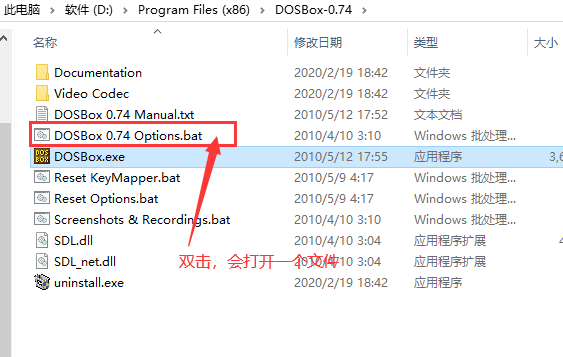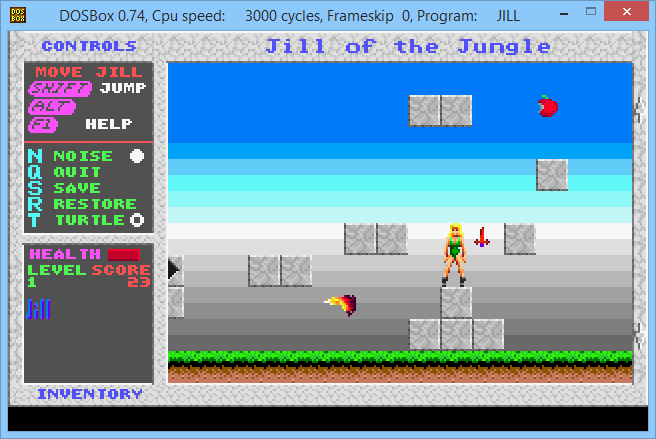

- DEBUG EXE FOR DOSBOX HOW TO
- DEBUG EXE FOR DOSBOX INSTALL
- DEBUG EXE FOR DOSBOX CODE
- DEBUG EXE FOR DOSBOX DOWNLOAD
- DEBUG EXE FOR DOSBOX WINDOWS
The code returns DOS error code 08h (insufficient memory) ofcourse, but in thisĬase it also returns the maximum available paragraphs. Paragraphs (paragraph=16kb?) available to my program: I used the following code in a COM file to find out the maximum number of With INT21 function 48h and 49h, memory allocation and deallocation respectively. I want more than the standard 64k in a COM file so i started experimenting Maybe I’ll write another post about that.How does DOS manage the memory usage of a.
DEBUG EXE FOR DOSBOX HOW TO
Now I just need to learn how to use DOSBox’s debugger. The few minor problems I ran into, I commented about above. This turned out to be fairly straight forward and I didn’t hit many problems. I’m not sure if this meant I could have skipped downloading/compiling/installing them, or if they were needed by the DOSBox build process. The two files SDL.dll and SDL_net.dll already existed in my DOSBox folder, so I didn’t copy them over. I actually renamed dosbox.exe to dosbox-debug.exe and copied it to my already existing DOSBox folder so it would use the DOSBox configuration I already had set up.Copy the following files to your the DOSBox folder you just created:ĭ:\MinGW\msys\1.0\home\ your-user-name\dosbox\src\dosbox.exeĭ:\MinGW\msys\1.0\home\ your-user-name\SDL-1.2.15\bin\SDL.dllĭ:\MinGW\msys\1.0\home\ your-user-name\SDL_net-1.2.8\.libs\SDL_net.dll.Make a DOSBox folder where you want DOSBox to be.configure –enable-core-inline –enable-debug=heavy LDFLAGS=”-static-libgcc -static-libstdc++ -s” LIBS=”-lvorbisfile -lvorbis -logg” configure –disable-shared –prefix=/mingw LIBS=”-lvorbisfile -lvorbis -logg” #define PNG_Z_DEFAULT_NOFILTER_STRATEGY \ Edit the file D:\MinGW\msys\1.0\home\ your-user-name\libpng-1.6.18\ pnglibconf.h and at the bottom of the file, add ” \” (space followed by a backslash, without the quotes) to the end of the following lines:.Apparently running make generated the file. I ended up trying to run make and seeing it fail, then noticed the file now existed. It just said to edit the file, but it didn’t exist for me. The site I was following didn’t mention running make after. The make command will fail, but it will generate a file you need to edit in order to make the make command succeed.configure –disable-shared –prefix=/mingw Edit the file D:\MinGW\msys\1.0\home\ your-user-name\SDL_net-1.2.8\SDLnet.c and add the line.
DEBUG EXE FOR DOSBOX DOWNLOAD
Download to D:\MinGW\msys\1.0\home\ your-user-name\.Download to D:\MinGW\msys\1.0\home\ your-user-name\.Debugger support (the main reason I went through all this).Compressed audio on disk images support.The following library are either needed or are optional. The site I was following the instructions on said to enter the command mount D:\MinGW\msys\1.0 /mingw, however I found that the /mingw directory already had my D:\MinGW\msys\1.0 folder mounted.This will open the MinGW terminal window. Browse to D:\MinGW\msys\1.0\ and run MSYS.BAT.When this finishes, close MinGW Installation Manager.
DEBUG EXE FOR DOSBOX INSTALL
This will download and install the packages you selected. Open the Installation menu and select Apply Changes.


When the MinGW Installation Manager opens, select “mingw-developer-toolkit”, “mingw32-base”, “mingw32-gcc-g++”, and “, “msys-base”.Run MinGW installer, accepting the defaults (I changed the install directory to “D:\MinGW\” instead of “C:\MinGW\”.Download, compile, and install libraries that DOSBox needs to compile.
DEBUG EXE FOR DOSBOX WINDOWS

The main site I used while figuring all this out was. If this serves no other purpose, it will help my future-self figure out how to do this again if I need to. This is a step-by-step “walkthrough” of what I learned. I couldn’t find a prebuilt “Heavy Debug” version of DOSBox quickly, so I decided to figure out how to download the source code for DOSBox and compile it with the “Heavy Debug” feature enabled myself. Then, I learned there was a “Heavy Debug” version that included additional debugging functionality (such as setting breakpoints when a memory location changes). I searched online and found a downloadable version of DOSBox that was built with the debug feature enabled. I was using DOSBox and the normal DOS DEBUG command to do this, until recently when I discovered that DOSBox has a debug build. Being able to step through their code as they’re running and set breakpoints is a majorly useful tool. One of my favorite hobbies is reverse engineering 16-bit x86 DOS games.


 0 kommentar(er)
0 kommentar(er)
